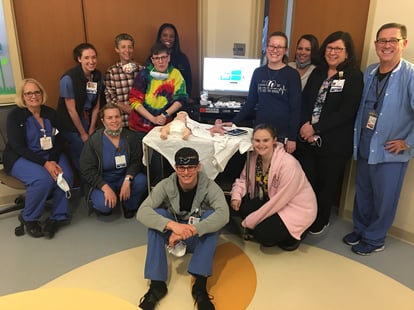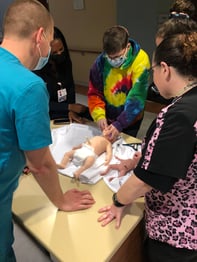Celebrating a baby shower is a fun tradition to welcome a new addition—even if that new family member is, in fact, a simulation manikin.

At our Hopewell, New Jersey-based Pediatrix Medical Group practice at Capital Health Medical Center, members of our Mednax family and the nurses in the neonatal intensive care unit recently welcomed baby manikins ‘Lola’ and ‘MJ’. A ‘birthing mom’ manikin was also welcomed into the neighboring Obstetrix Medical Group practice, also based at Capital Health Medical Center.
Don't have time to read? Listen to the blog here!
‘Lola’ and ‘MJ’ are normally very well-behaved newborns unless the practice is in the middle of an active simulation exercise.

As high-fidelity infant manikins, they can turn blue, cry, grunt, be intubated and even experience the occasional seizure. MJ, or Mike Junior, is a full-term baby manikin and was named after Michael Friedman, M.D., a neonatologist at the practice. Lola is a premature infant, meant to represent a baby born at 26-27 weeks' gestation.
Having access to both full-term and premature infant manikins is not something that’s very common, adding value to the practice’s developing simulation program. “These are high stakes simulations and things are happening quickly,” said Renee Behme, M.D., neonatologist and leader of the practice’s simulation program. “The fluidity of the team is important. As the neonatologist, when you have the members of the team who know what needs to be done and can anticipate the next step, it is really helpful—it's the best thing for the patient.”
A foundation for simulation
In November 2018, Mednax’s National Simulation Program visited the practice site, conducting a two-day visit with three neonatal-based scenarios and an OB post-partum care case. One year later, practice representatives also participated in the Mednax Introduction to Simulation Workshop in Fairfax, Virginia. Gillian Gonzaba, APRN, NNP-C, CHSE, LSSBB, Associate Director for Mednax’s HRO/Patient Safety a
nd Simulation, recalls the team was “highly engaged” with the simulation and eager to develop their own program based on the inspiration from the national simulation program and the resources learned.
Following the simulation trainings and subsequent time spent developing a simulation and manikin program plan with Capital Health, in late 2020, the practice was notified that the manikin purchase was being supported by the hospital with supplemental grant funding through the Wawa Foundation.
“It is wonderful for hospitals to be able to see the true value of simulation and support the development of a high-fidelity simulation program,” said Gonzaba. “To have our hospitals recognize that and provide our practices with resources to develop state-of-the-art programs—it's a huge win for our simulation team. This is a great opportunity to show what our sites are doing and to showcase what success and value-add our simulation services can provide.”
Simulation in practice
Since welcoming the new manikins, Dr. Behme reports that the simulation program is off to an active start, beginning simulations for NICU and newborn nursery nurses as well as planning simulations for the hospital’s emergency medical services teams and its developing emergency medicine residency program.
This May, they planned an in-depth pneumothorax scenario in the NICU, where the team was tasked with doing an assessment on a baby and ultimately placing a pigtail catheter, a technique Dr. Behme says is not something their medium-sized unit often gets to practice. “In the NICU, everything we do is about teamwork,” says Dr. Behme. “We’re dealing with very premature infants and it's really imperative that every person on the team knows what their role is and what is needed at that moment. I think by doing simulations and education and training, that helps each member of the team really understand their important role in whatever clinical situation arises.”
“We love to hear about and share these success stories,” says Gonzaba. “They were able to experience simulation, attend the workshop, garner all the education and tricks of the trade in order to acquire three new manikins and truly build this program from the ground up.”
About the Mednax Simulation Program
The Mednax Simulation Program offers clinicians across the nation opportunities to hone their skills and improve the care they provide to patients. The program covers a broad range of simulation scenarios focusing on education, communication, patient safety and quality improvement. As of April 1, 2020, the Simulation Program has earned full accreditation status from the Society for Simulation in Healthcare in the areas of Teaching/Education and Systems Integration.
Interested in launching a Simulation Program at your practice?

